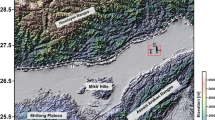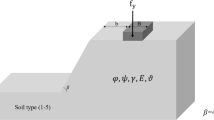Abstract
Rate of penetration (ROP) of a tunnel boring machine (TBM) in a rock environment is generally a key parameter for the successful accomplishment of a tunneling project. The objectives of this work are to compare the accuracy of prediction models employing partial least squares (PLS) regression and support vector machine (SVM) regression technique for modeling the penetration rate of TBM. To develop the proposed models, the database that is composed of intact rock properties including uniaxial compressive strength (UCS), Brazilian tensile strength (BTS), and peak slope index (PSI), and also rock mass properties including distance between planes of weakness (DPW) and the alpha angle (α) are input as dependent variables and the measured ROP is chosen as an independent variable. Two hundred sets of data are collected from Queens Water Tunnel and Karaj-Tehran water transfer tunnel TBM project. The accuracy of the prediction models is measured by the coefficient of determination (R 2) and root mean squares error (RMSE) between predicted and observed yield employing 10-fold cross-validation schemes. The R 2 and RMSE of prediction are 0.8183 and 0.1807 for SVMR method, and 0.9999 and 0.0011 for PLS method, respectively. Comparison between the values of statistical parameters reveals the superiority of the PLSR model over SVMR one.
Similar content being viewed by others
References
YAGIZ S, GOKCEOGLU C, SEZER E, IPLIKCI S. Application of two non-linear prediction tools to the estimation of tunnel boring machine performance [J]. Engineering Applications of Artificial Intelligence, 2009, 22: 818–824.
MANSOURI M, MOOMIVAND H. Influence of rock mass properties on TBM penetration rate in Karaj-Tehran water conveyance tunnel [J]. Journal of Geology and Mining Research, 2010, 2(5): 114–121.
LI X B, SUMMERS D A, RUPERT G, SANTI P. Experimental investigation on the breakage of hard rock by the PDC cutters with combined action modes [J]. Tunnelling and Underground Space Technology, 2001, 16(2): 107–114.
LI Xi-bing, ZHAO Fu-jun, SUMMERS D A, RUPERT G. Cutting capacity of PDC cutters in very hard rock [J]. Transactions of Nonferrous Metals Society of China, 2002, 12(2): 305–310.
GRAHAM P C. Rock exploration for machine manufactures [C]// Symposium on Exploration for Rock Engineering. Johannesburg, Balkema, 1976: 80–173.
FARMER I W, GLOSSOP N H. Mechanics of disc cutter penetration [J]. Tunnels and Tunnelling, 1980, 12(6): 22–25.
BARTON N. TBM performance estimation in rock using Q TBM [J]. Tunnels and Tunneling International, 1999, 31(9): 30–33.
SAPIGNI M, BERTI M, BETHAZ E, BUSILLO A, CARDONE G. TBM performance estimation using rock mass classifications [J]. International Journal of Rock Mechanics and Mining Sciences, 2002, 39(6): 771–788.
GONG Q M, ZHAO J. Development of a rock mass characteristics model for TBM penetration rate prediction [J]. International Journal of Rock Mechanics and Mining Sciences, 2009, 46(1): 8–18.
YAGIZ S. Utilizing rock mass properties for predicting TBM performance in hard rock condition [J]. Tunnelling and Underground Space Technology, 2008, 23(3): 326–39.
JAFAR K H, KOUROSH S, BAHRAM R, JAMAL R. Performance prediction of hard rock TBM using Rock Mass Rating (RMR) system [J]. Tunnelling and Underground Space Technology, 2010, 25(4): 333–345.
ALVAREZ GRIMA M, BRUINES P A, VERHOEF P N W. Modeling tunnel boring machine performance by neuro-fuzzy methods [J]. Tunnelling and Underground Space Technology, 2000, 15(3): 259–269.
ZHAO Z Y, GONG Q M, ZHANG Y, ZHAO J. Prediction model of TBM performance by ensemble neural networks [J]. International Journal of Geomechanics and Geoengineering, 2007, 2(2): 123–128.
YAGIZ S, KARAHAN H. Prediction of hard rock TBM penetration rate using particle swarm optimization [J]. International Journal of Rock Mechanics and Mining Sciences, 2011, 48(3): 427–433.
WOLD S, SJOSTROM M, ERIKSSON L. PLS-regression: A basic tool of chemometrics [J]. Chemometrics and Intelligent Laboratory Systems, 2001, 58(2): 109–130.
BOULESTEIX A L, STRIMMER K. Partial least squares: a versatile tool for the analysis of high-dimensional genomic data [J]. Briefings in Bioinformatics, 2007, 8(1): 32–44.
VAPNIK V N. The nature of statistical learning theory [M]. New York: Springer-Verlag, 1995: 5–78.
GOPALAKRISHNAN K, KIM S. Support vector machines approach to HMA stiffness prediction [J]. Journal of Engineering Mechanics (ASCE), 2011, 137(2): 138–146.
SHI X Z, ZHOU J, WU B B, HUANG D, WEI W. Support vector machines approach to mean block size of rock fragmentation due to bench blasting prediction [J]. Transactions of Nonferrous Metals Society of China, 2012, 22(2): 432–441.
[20] R Core Team. R: A language and environment for statistical computing. R Foundation for Statistical Computing [M]. Vienna, Austria. URL http://www.R-project.org/. 2003.
MEVIK B, WEHRENS R. The pls package: Principal component and partial least squares regression in R [J]. Journal of Statistical Software, 2007, 18(2): 1–24.
KARATZOGLOU A, SMOLA A, HORNIK K, ZEILEIS A. kernlab-An S4 package for kernel methods in R [J]. Journal of Statistical Software, 2004, 11(9):1–20.
Author information
Authors and Affiliations
Corresponding author
Additional information
Foundation item: Project(2010CB732004) supported by the National Basic Research Program of China; Projects(50934006, 41272304) supported by the National Natural Science Foundation of China
Rights and permissions
About this article
Cite this article
Gao, L., Li, Xb. Utilizing partial least square and support vector machine for TBM penetration rate prediction in hard rock conditions. J. Cent. South Univ. 22, 290–295 (2015). https://doi.org/10.1007/s11771-015-2520-z
Received:
Accepted:
Published:
Issue Date:
DOI: https://doi.org/10.1007/s11771-015-2520-z




